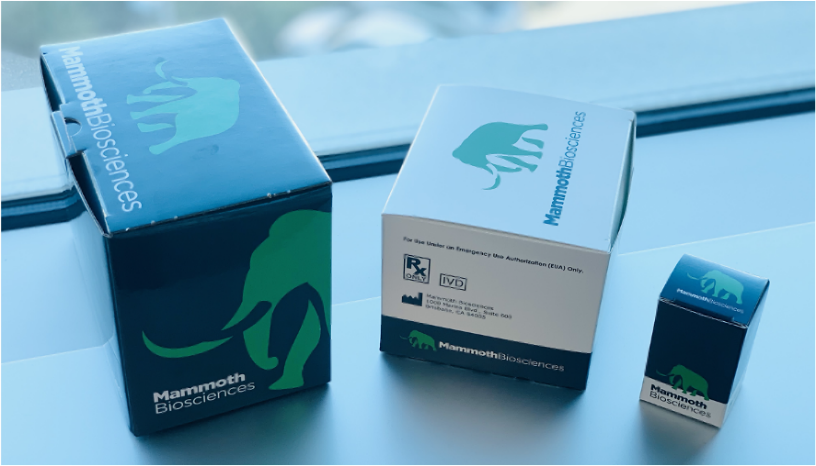IVD Case Study: CRISPR-based Assay from Mammoth Biosciences
Diagnostic assay project situation
Mammoth Biosciences is developing a turnkey workstation to run their CRISPR-based DETECTR BOOST SARS-CoV-2 molecular assay on automated liquid handling equipment. This high-throughput system can perform 1,500 tests in a single 8-hour shift with minimal user interaction. Once approved, the diagnostic workflow will reduce the time required for testing while maintaining the gold standard accuracy of polymerase chain reaction (PCR).
Mammoth Biosciences recently secured funding from the National Institute of Health’s Rapid Acceleration of Diagnostics (RADx) program to scale this workflow to increase both centralized and decentralized testing capacity, amplifying efforts to combat the COVID-19 pandemic. To meet anticipated demand, Mammoth sought a partner to produce the DETECTR master mix, which included three unique reagents, at commercial scale.
Section Overview
Product Development Needs for a Reagent Kit
Assay Design
Integration
Reagent Manufacturing
- Process Development
- Process Validation
- Specification Creation
- Quality Control Testing
- Batch Record Generation
- Supply Chain Management
Design Verification
Design Validation
Our Operational Support for the CRISPR-based assay project
As part of reagent manufacturing, Mammoth Bioscience also required help with test methods and specifications for raw materials, intermediates and final products, as well as validations that needed completion for manufacturing and QC. A holistic set of integrated workstreams was established and included manufacturing development and scale up from milliliters to liters of the master mix, QC, supply chain, packaging and label design and project management. In addition to managing these workstreams, time was of the essence for the project as Mammoth Bioscience sought to obtain emergency use authorization (EUA), enabling the kits to get to market as soon as possible.
The customized solution for Mammoth Bioscience’s CRISPR-based assay
The project included a manufacturing development stage in which we designed the kits, the QC specifications and test methods to ensure all products met specification. We also proposed a validation plan for critical manufacturing processes, QC methods and accelerated and real-time stability studies.
Manufacturing of the pilot and validation batches took place at our facilities in St. Louis, Missouri. Following set up and development, a 20-kit pilot lot was produced with the goal of proving that the R&D processes could successfully move to our operations groups in St. Louis. The pilot lot was also used to train the manufacturing, QC, and packaging scientists in these processes and test the shipping conditions. The three-part reagent kit has one module that remains at room temperature, one that must be frozen and a third that must be kept cool. A test of the shipping conditions ensured each of the kits arrived at the same time and were maintained at the appropriate temperature.
We also had to ensure that a 96-well plate could be shipped without leaking or being jostled or broken.
“It became readily apparent that our manufacturing partner understood us and listened to our problems. They had valid ideas about how to solve problems. They listened, they brainstormed. I didn’t have to worry. I knew the scale-up was going to happen and it was going to happen as fast as it possibly could under the circumstances.”
Tim Patno, VP of Product Development, Mammoth Biosciences.

Figure 1: Three unique reagents are used in Mammoth Bioscience’s CRISPR-based SARS CoV-2 assays, all with different shipping requirements.
Three batches were manufactured at production scale for validation and accelerated and real-time stability testing. Failure mode and effects analyses (FMEA) were also conducted and included the risk associated with the project overall, raw materials, the short timeline and specific manufacturing and packaging processes involved in creating the kit. Control points and specific actions were established to mitigate those risks.
The results of Mammoth Bioscience’s CMO project for IVD assay reagents
We manufactured the first commercial lot less than six months from project initiation. The manufacturing process was successfully scaled from milliliters to liters and along the way, we identified and solved potential issues related to the formulation of the reagent. Quality control team members met on a weekly or biweekly basis to advance the overall strategy, development and validation. And while all meetings were necessarily virtual, the process was deemed “fantastically efficient” by Mammoth Biosciences leadership. This project not only relied on our manufacturing, QC and supply chain expertise, but a commitment to collaboration and earning the trust of the Mammoth Biosciences team.
This highly collaborative and strategic engagement resulted from several critical success factors including:
- Follow-through during discovery phase
- Meeting short-term commitments
- Understanding our complex and complementary roles and needs
- Offering valid ideas for how to solve real problems
- Listening and effectively brainstorming together
- Fast, positive response to requests
Ensuring success of Mammoth Bioscience’s CRISPR-based IVD assay
To ensure the long-term success of a project during those reviews, we look at sales for the product and future demand. If we expect demand to spike, we talk about ways to mitigate risk such as purchasing additional equipment or hiring additional employees. like this, we continually assess supply chains risks, in part, through quarterly business reviews with our clients. We also explore product improvements and whether we can source additional raw materials at a lower cost? Or, if a customer is currently only selling a kit in North America, but would like to sell the kit in Europe, we look at duplicating this process at one of our European sites so the kit can be manufactured close to where it’s going to be distributed and used. We also study long term demand at three-to-five years out; each of our production sites has a three-to-five-year strategy, and so we work together with both our customers and our sites to ensure we have or can build capabilities to help our customers grow.
如要继续阅读,请登录或创建帐户。
暂无帐户?